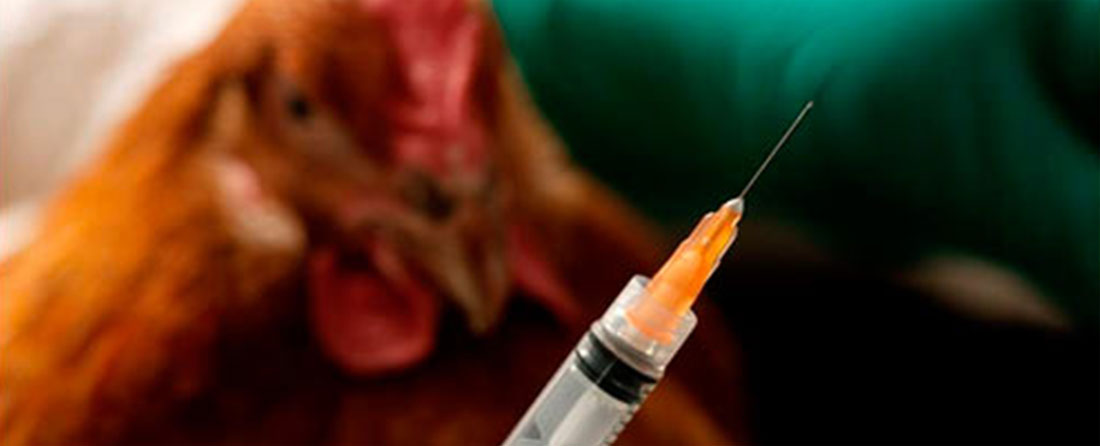Preventive Veterinary Microbiology - the Miki Bojesen group

Our aim is to design novel approaches for disease prevention through development of vaccines and alternative antimicrobial treatments. Our main focus is to identify and understand factors involved in disease initiation and progression in animals to improve welfare and productivity. Infectious diseases in poultry, pigs, fish and horses are the main focus of our research.
Research Focus
The Preventive Veterinary Microbiology group specifically focus on bacterial vaccine development using bacterial extracellular vesicles (EVs). EVs are spherical spheres naturally shed from he surface of most bacterial cell. EVs resembles the surface of a live bacterium with proteins and other structures in their natural confirmation. We have different projects investigating EV content, EV production and extraction, and different ways to administer the EVs.
An additional major focus area of the Preventive Veterinary Microbiology group is microbiome management. Microbiome management includes investigations of how pre-, pro- and synbiotic treatments influence particularly the gut microbiome in chickens, zebrafish and rainbow trout. Microbiome management has a big potential at increasing feed utility and lowering the negative effects of pathogenic bacteria.
Research Projects
Summary: Colibakterier udgør til stadighed den største enkeltstående sygdomsårsag hos konventionelle og økologiske fjerkræ. Vi har udviklet et nyt vaccinekoncept, baseret på såkaldt ydre membran vesikler (Outer Membrane Vesicles eller OMVs), som vi nu kan producere i store mængde og til en meget lav pris. Vaccinen yder bred beskyttelse og er samtidig meget sikker, da den ikke er levende. Et sidste led i udviklingen vedrører administrationsmetoden, som i dag kræver injektion i musklen. Vi har præliminære resultater fra vaccination med en forstøvet version af vaccinen, som ser lovende ud, men vi ønsker at undersøge denne applikationsmetode yderligere.
Vi vil teste OMV-vaccinens evne til at yde beskyttelse efter aerosolvaccination og efterfølgende smitte med forskellige typer E. coli. Vi vil udføre forsøg hvor forskellige vaccinationsdosis undersøges for evne til at stimulere et beskyttende immunrespons. Herudover vil afprøvning af forskellige tidsintervaller for vaccination der kan afklare aerosolvaccinationsmetodens praktiske anvendelsesmuligheder.
Undersøgelserne vil inkludere undersøgelse af antistofniveauer i serum og æggeblomme (skal give indikationer på niveau af maternelle antistoffer), samt graden af læsioner induceret efter aerogen smitte med E. coli i hhv. vaccinerede og ikke-vaccinerede, så vaccinationens beskyttende evne dokumenteres. Bred beskyttelse og lave produktionsomkostninger, som følge af storskala produktion af OMV’er, vil sammen med en billig og effektiv tildelingsmetode gøre det OMV-baserede vaccinekoncept til et slagkraftigt alternativ til de nuværende vaccinationsstrategier møntet på E. coli.
Den umiddelbare effekt af projektet vil inkludere en afklaring af OMV vaccinerne potentiale til at nedbringe vaccinationsomkostningerne og samtidig forbedre beskyttelsen i forhold til de nuværende vaccinationsstrategier, samt, på længere sigt, at forbedre sundhedstilstanden i dyrene og mindske behovet for antibiotikabehandling.
Bevillingsgiver: Fjerkræafgiftsfonden
Summary: Our aim is to test a promising vaccine technology for animals, which can lower the use of antibiotics and thereby minimize the risk of antimicrobial resistance development without compromising animal health and welfare. Our vaccine solution is based on bacterial extracellular vesicles (EVs). We have optimized the production of EVs from hyper-vesiculating bacterial strains via an innovative fermentation and extraction method permitting extremely cost-effective manufacturing of high-quality vesicles in large quantities. EVs have proved highly effective at inducing protective immunity through their membrane-embedded immunogenic proteins in native conformation. This makes EVs resemble a live bacterium, yet a very important difference is the safety difference between the existing live-vaccine and the EV-based non-live vaccine. EVs present no risk of inducing disease. The majority of data obtained so far is based on injection of the vaccine material. Our aim, however, is to develop an application method that allows needle-free vaccination. We have obtained preliminary results from an aerosol-based delivery that has the potential to disrupt disease prevention in the animal health sector.
Bevillingsgiver: Innoexplorer | Innovationsfonden
Summary: Aspergillose og mykobakteriose er infektioner, der rammer fugle i zoologiske haver, fjerkræ i landbruget og vilde fugle og forårsager kronisk sygdom, forringet velfærd og økonomiske tab. En sikker diagnose kræver oftest aflivning, hvilket ikke harmonerer med artsbevarelse. I dette projekt vil vi udvikle ultra-sensitiv diagnostik via nye, innovative teknologier, der muliggør effektiv påvisning af patogener i minimale mængder. Herved vil hurtig individuel behandling og opfølgning kunne realiseres.
Bevillingsgiver: Innovationsfonden og Københavns Zoo
Summary: Understanding the interplay between animals and microorganisms associated with them has been recognised as an essential step for improving and optimising animal production, both in Europe and worldwide. To understand the biomolecular interactions that impact production processes, researchers are implementing novel analytical strategies based on analysing host genomes, their microbial metagenomes as well as the different ‘omic layers interconnecting them — the so-called holo’omic approach. However, in conventional multi-omic approaches, the intestinal ecosystem is analysed as a black box: we may know which microorganisms are there, which genes are expressed, and which metabolites are present in the system. But such information, derived from conventional DNA/RNA sequencing and mass spectrometry, does not provide any information about how the different elements are interacting in the ecosystem or how they are spatially distributed. The importance of spatial distribution of organisms has long been recognised in ecology, and more recently, also in the intracellular genomic architecture. Hence, acknowledging the three-dimensional (3D) conformation of DNA molecules, cells and organisms is increasingly appreciated to be a key element for advancing the understanding of biomolecular interactions that occur at intra- and inter-cellular level. Such information can be obtained by fixing biological samples in ways that preserve their 3D structures, and analysing the nucleic acids and metabolites present in thin multi-orientation cross-sectional slices. Data generated in this way can be analysed in a statistical framework, so as to reconstruct the spatial situation of different molecules, which ultimately enables identification of the 3D conformation of the molecules, and thus ascertain which bacterial cells are close to which other, or which metabolite is next to which bacterial or eukaryotic cell, for instance.
Bevillingsgiver: Horinzon 2020 – Research Innovation Act
Summary: Vi vil udvikle en cutting-edge screeningsmodel som hurtigt, billigt og effektivt kan validere probiotiske bakterier til brug i fiskefoder. Med udgangspunkt i regnbueørredproduktion, vil vi udvikle en model bestående tre trin: 1) potentielle bakterier laboratoriescreenes for ønskede egenskaber, 2) lovende kandidater testes i en særligt udviklet zebrafiskemodel hvor deres evne til at kolonisere fisks tarmsystem undersøges, 3) probiotiske kandidater med størst potentiale testes i fodrings- og infektionsforsøg med regnbueørreder. Efter hvert af de to indledende trin vil feltet af kandidater vurderes og indsnævres, så de endelige forsøg vil kunne udføres på et langt mere optimalt grundlag end hidtil muligt. Modellen vil således accelerere en fremtidig screeningsprocess til et givent foder, samtidig med at omkostningerne til udvikling og karakterisering af probiotiske fodertilsætninger minimeres. Probiotika i fiskefoder har to hovedformål: A) at forebygge bakterielle infektioner, hvilket vil have en reducerende effekt på antibiotikaforbruget, samt B) at sikre en mere effektiv udnyttelse af moderne fiskefoder med øget andel af svært fordøjelige plantekomponenter, hvilket vil have en gunstig effekt på vækst og rentabilitet, samt udledningen af næringsstoffer som kvælstof og fosfor. Chr. Hansen, Aller Aqua og forskere fra Københavns Universitets kombinerede know-how, tekniske kompetencer og faciliteter vil sikre en stærk udviklings-pipeline til en globalt relevant produktgruppe.
Bevillingsgiver: Grønt udviklings- og Demonstrations Program (GUDP), Chr. Hansen, Aller Aqua.
Projektets formål er at undersøge smitterisikoen ved anvendelse af ”sidestrømme” fra fjerkræproduktionen (i dette projekt chickpulp). En del restprodukter udnyttes i dag ikke optimalt, da de regnes for risikobehæftet. Chickpulp er et eks. på et produkt med højt proteinindhold der kunne udnyttes som en værdifuld ressource f.eks. som insektlarvefoder eller foder til kæledyr. Køkkenaffald er ligeledes et produkt, der måske kunne udnyttes som insektlarvefoder, men som ligeledes regnes for risikobehæftet og derfor ikke umiddelbart kan anvendes som ernæringssubstrat til insektlarver.
Vi vil undersøge, om relevante veterinære patogener (virus, bakterier og coccidier) overlever i chickpulp (syrnet pulp fremstillet af udsætningshøner). De udvalgte patogener (Salmonella, campylobacter, E. faecalis, C. perfringens, porcint parvovirus, aviær influenza og eimeria arter) tilsættes det syrnede chickpulp i en kendt koncentration og efter relevante tidsintervaller isoleres og kvantificeres patogenerne fra chickpulpen igen. I et efterfølgende forsøg anvendes chickpulp, tilsat de nævnte patogener, som ernæringssubstrat for Black Soldier Fly Larvae (BSFL) og de tilsatte patogener identificeres og kvantificeres i de udvoksede larver efter disse er behandlet og omdannet til insektmel som det gøres hos ENORM A/S.
Den frembragte viden skal anvendes som dokumentation til fødevarestyrelsen for at få opmærksomhed omkring den restriktive kategorisering af chickpulp som kategori 2 materiale. Målet er, at chickpulp enten undtages fra den pågældende kategorisering eller der laves en ny kategorisering som muliggør at chickpulp kan udnyttes f.eks. til kæledyrsfoder eller til ernæring af BSFL. Vi håber at dette projekt vil kunne åbne op for mere nuanceret lovgivning, så andre ressourcer som mad- og køkkenaffald kan udnyttes mere cirkulært i fremtiden.
Bevillingsgiver: Fjerkræafgiftsfonden
Projektperiode: 2/1-2024 til 31/12-2024
Formålet er at undersøge sekretoriske proteiner fra hønens spoleorm, Ascaridia galli, i forhold til deres immunmodulerende evne, samt at identificere kandidater, der kan anvendes som vaccineantigen ved hjælp af bakterielle membran vesikler. Spoleorm udgør en kraftigt stigende problemstilling hos æglæggende høner med adgang til udendørsarealer, som i dag udgør ca. 40 af den samlede danske konsumægsproduktion. Vi vil undersøge hvilke faktorer, som gør de op til 12 cm store orm i stand til at gemme sig for hønens immunologiske respons, med henblik på at udvikle en metode der kan kontrollere spoleormene. Hidtil har kontrollen med ormene været med antiparasitære midler, som har tilbageholdelsestid og giver tabt indtjening og ekstra administrativt arbejde for den enkelte landmand. Vi vil finde de faktorer som ormene udskiller og dæmper hønens immunforsvar i tarmen.
Ved at fokusere for de faktorer der tillader ormene at opholde sig uset i hønsenes tarm, kan vi designe en nye vaccine for gør hønen i stand til at erkende ormenes tilstedeværelse og inducere et effektfuldt immunrespons.
Vi vil identificere ormenes koloniseringsfaktorer, koble dem med E. coli OMV platformsteknikken og afprøve den teknologis evne til at blokere den immundæmpende effekt af hønens spoleorm. Såfremt det lykkedes, vil teknologien have et stort potentiale som forebyggelsesmetode der ikke kræver tilbageholdelse af æg og andre produkter.
Projektperiode: 2/1-2024 til 31/12-2024
Bevillingsgiver: Fjerkræafgiftsfonden
Group Leader
Anders Miki Bojsen
DVM, Professor
Phone +45
miki@sund.ku.dk
Stigbøjlen 4
DK - 1870 Frederiksberg C
Group members
| Name | Title | Phone | |
|---|---|---|---|
| Aagaard, Katrine Wedel | Laboratory Technician | +4535332766 | |
| Bertelsen, Mads Frost | Affiliate Professor | ||
| Bojesen, Anders Miki | Professor | +4523844188 | |
| Farooq, Rimsha | PhD Student | ||
| Poulsen, Louise Ladefoged | Associate Professor | +4535321295 | |
| Ryttov, Dan Friis | Laboratory Technician | +4535336531 | |
| Zhou, Qian | PhD Student |

